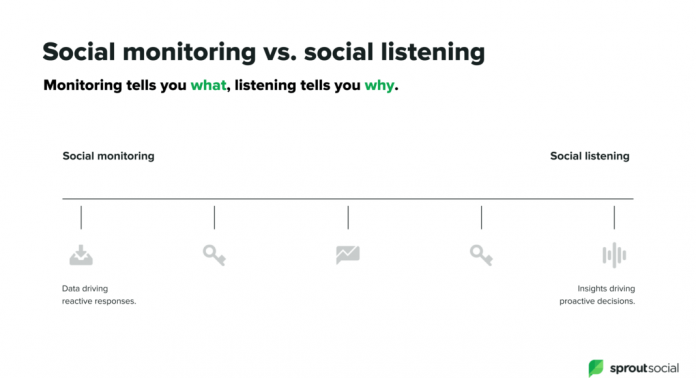When you hold a conversation, the success of the interaction relies on your ability to listen to the other person and give appropriate responses.
The same thing is true of social media. After all, social media platforms are expressly designed as platforms for interaction.
So why aren’t businesses listening to the conversation?
If you’re not using social listening on your platforms, your business is missing a critical component of the discussion. Here’s what it is, what you can use it for, and how to use it.
What is Social Listening?
Social listening is a lot like regular listening. But instead of listening to a spoken conversation, you’re listing to a social media conversation.
It’s not a conversation between two people. It’s not even necessarily a conversation between your brand and your customers.
It’s a conversation happening across all of your customers and across your industry.
Social listening is the means of hearing it.
Basically, it’s a technique of collecting data to understand how, when, and why these conversations are happening. This, in turn, helps your brand make informed marketing decisions to improve your content strategy, build smarter marketing campaigns, and perform better than your competitors.
Also Read: 10 Reasons To Make Use Of SMS In Your Marketing Strategy
How It Works
Consumers spend 1/7 of their waking lives on social media and social messaging apps. And since there are 3.48 billion people using social media, that means there are billions of conversations occurring across social media platforms every single day.
Let’s say you want to analyze that data.
To do this, you choose a social aggregator tool like Data Sift, combined with a listening analytics platform.
The listening analytics platform uses keywords to turn the unstructured data from the social aggregator into structured data. You just need to type in keywords.
Once the listening tool organizes the data, you can interrogate the data to see the full extent of the trends before you.
The key here is knowing what to tell the listening tool. It won’t look for something unless you tell it what to look for. It’s a good idea to check and refine these keywords periodically to make sure you’re getting useful data.
Once the listening tool knows how to organize the data for you, you can analyze the data for common conversations and communities and segment it further. This additional refinement will help you test the trends you see–look for sources that will prove or disprove your data.
From there, you can use these insights to target your audience.
Monitoring vs. Listening
Before we go any further, it’s important to understand the difference between social monitoring and social listening.
Social monitoring is something you do already. Or you should already be doing it if you want your social media to perform.
Monitoring tells you what’s happening, what your customers are talking about, what they’re responding to.
Listening tells you why it’s happening so that you can understand the bigger picture.
Both are useful (you can’t have social listening without social monitoring) but you need listening to take the next step.
Also Read: Why Email Marketing Is Important for Your Internet Marketing
Reasons to Use Social Listening
Let’s say you’re a customer-oriented company. You want your company to be better.
How can you be truly customer-oriented if you don’t know what your customers are talking about? More importantly, how can you market to your customers if you don’t know why something caught their attention?
There are two main reasons why you should incorporate listening: the customer side and the business side.
Customers Like It When You Respond
From the customer side, the logic is simple. Customers like it when you respond.
More to the point, they like it when you have a personalized experience, one that helps them relate to your brand.
It’s part of a larger push for personalized marketing. You need to know the customer, you need to remember them, and you need to give them an experience that suits them based on what you know.
One of the easiest ways to do this is simple: respond to them on social media.
Customers like it when brands join conversations because it makes them feel like there’s a real person behind the brand who’s paying attention to them.
Social listening allows you to do more than just respond. It allows you to provide truly informative, valuable responses.
You Can Track Your Growth
From the business side, listening allows you to see where your brand is.
Let’s say you weather a scandal. It happens, despite your best intentions. And when it does, social listening allows you to respond effectively.
When something goes wrong, you can use listening tools to analyze the incident. You can see if it has negatively impacted your following, sales, or other metrics. This lets you see whether it’s a passing phase or whether it’s a deeper scandal that requires greater attention.
It also allows you to see where things are going wrong.
Let’s take a different route. Let’s say the scandal wasn’t yours, but your competitor’s.
Here, again, social listening can help you.
It allows you to see where things went sour so that your brand can avoid a similar misstep–and outperform your struggling competitor.
Strategies for Social Listening
You know why you need social listening. Now let’s talk about how to do social listening.
Let’s say, for example, you want a leg up on the competition. Understandable, especially in a highly competitive social media environment.
You can use social listening to get a sense of why customers are dissatisfied with a competitor’s product (and what you can do better). You can use it to spot new products when they roll out and how consumers are responding to it.
You can also use it to measure consumer response to your product compared to a similar competitor product.
Let’s say you want to cast a wider net. Let’s say you want to take a look at the ripples in your whole industry.
Social listening allows you to keep your ear to the wind for frequently asked questions, spot gaps in the industry, or any industry shakedowns that could travel back to your company.
Also Read: How to Activate YouTube on devices
Turning Social Listening into a Smarter Brand
Social listening isn’t just about listening in on your customers.
It’s about bringing your brand to the table. It makes you an active player in the conversation and shows customers that you’re paying attention and, more importantly, that you care about what they have to say.
And just like listening in a human conversation, social listening gives you the tools to respond appropriately in a digital conversation.











